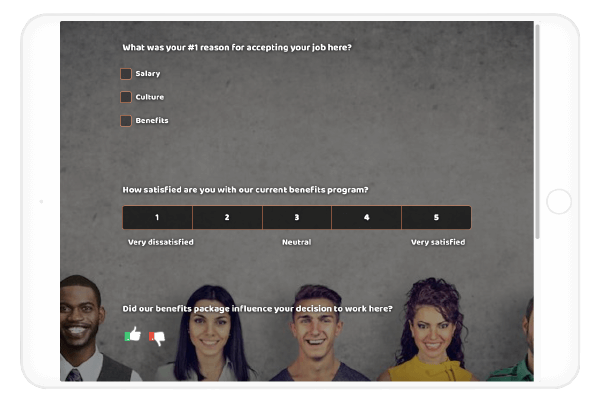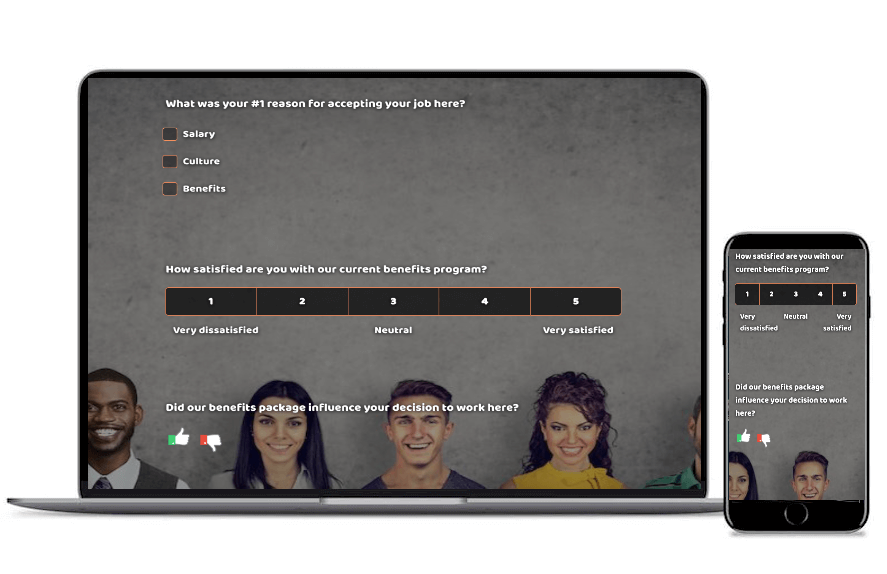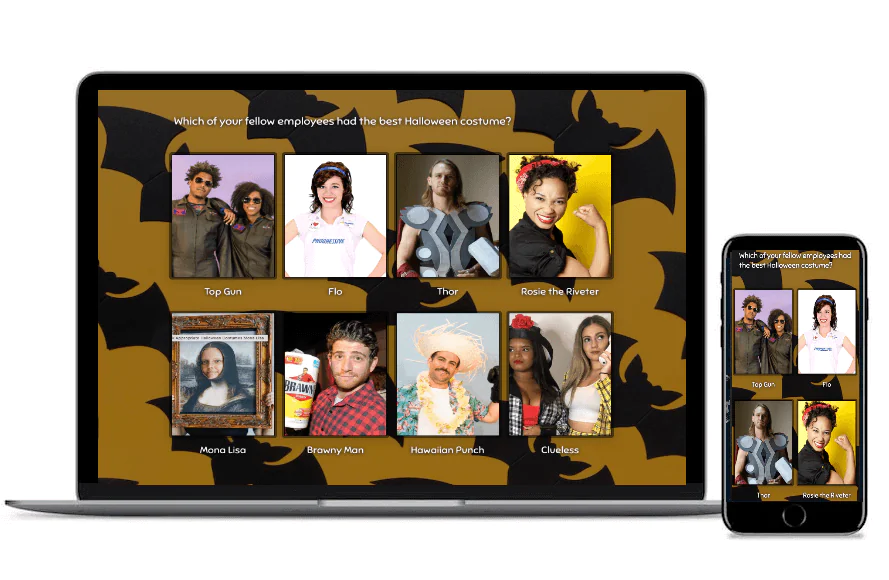Nearly 50% of American workers say they are very satisfied with their current job, and another 30% are somewhat satisfied. The remainder report being either somewhat dissatisfied or very dissatisfied. Of those that are satisfied with their job, respondents in salaried positions tend to be happier in part because they typically have a robust set of employer-provided benefits. By contrast, workers who are in retail, service, or manual occupations have fewer benefits and thus lower levels of satisfaction.
Create your employee benefits survey, form, or poll now!
Because employee benefits can greatly impact employee satisfaction and retention, it’s vital that you use an employee benefits survey to find out what is important to your employees and what you could offer them to improve job satisfaction levels.
Employee Benefits Statistics
Here are some quick facts about employee benefits in the workplace, courtesy of the Pew Research Center.
- Benefits are more common among workers with at least a bachelor’s degree.
- The youngest and oldest segments of the workforce – those who are 18 to 29 or 65 and older – are less likely to be offered benefits.
- Full-time workers are twice as likely as part-time workers to say that their employer offers benefits to them.
- Government workers are the most likely to have access to benefits while private company and nonprofit employees are less likely to have benefits.
- About 40% of American workers say their employer provides tuition reimbursement for skills training or additional education.
What Are Employee Benefits Surveys?
Employee benefits surveys are designed to collect your employees’ opinions about your benefits program (or lack thereof). These surveys can range in detail and number of questions but typically ask about benefits, perks, wellness programs, health coverage, and more. Asking employees about benefits is important if you want to keep them happy, productive, and motivated – not to mention, keeping them on the payroll.
Importance of Employee Benefits Surveys
Choosing employee benefits shouldn’t be a guessing game. Without employee input, you may waste money on programs your employees won’t use, while not offering them what they actually do need. A solid, employee-informed benefits program can help your company attract talent and retain your best employees.
Of course, to get responses and honest insight, you need to craft your survey in a way that captures the most relevant insight. For example, employees who work remotely may have a different set of benefits needs than those who work on-site. Later, we’ll provide employee benefits questions to get you started and some tips for crafting a survey that gets responses.
One final bit of food for thought: There are generational differences between older and younger employees. Some members of the younger generations prioritize company culture over salary, so offering meaningful and diverse benefits has become a crucial differentiator in the ongoing “talent wars.” An employee benefits survey can help you be sure what you offer is tuned into the needs of these younger employees, such as Millennials and Gen Z.
Employee Benefits Survey Questions
Here are some questions to consider asking about different benefits that may be important to your employees.
General Employee Benefits Questions
General employee benefits questions can help you determine whether your employees are satisfied with what you provide them and get to the heart of what they really want.
- Are you satisfied with the benefits provided to you?
- Did our benefits program influence your decision to work here?
- Are there benefits not currently offered that you think should be included in the program?
Health Insurance Survey Questions
According to job search and company review site Glassdoor, employees said health insurance is, by far, the most important benefit an employer can offer. Here are some sample healthcare benefits survey questions to consider:
- Have you signed up for our health insurance program?
- Are you satisfied with the level of health insurance provided?
- Do you use individual health insurance or a family plan?
Membership Benefits Survey Questions
Some employers offer membership benefits, most frequently gym discounts. This can reduce their insurance costs and create healthy, happier employees.
- Do you use our gym membership benefits?
- Does this benefit support your personal fitness goals?
- Would you be upset if we discontinued the gym membership benefits?
Retirement Benefits/401(k) Survey Questions
Next to healthcare, retirement and long-term savings are one of the most valuable benefits that you can offer employees. Offering a 401(k) plan helps employees plan for their future, while providing companies with significant tax breaks and deductions!
- Are you contributing to a 401(k)?
- Do you feel the company’s contribution to your retirement funds is generous?
- Are you happy with the company’s employee retirement plan program?
Stock Options Survey Questions
Stock options are a great way to motivate employees and get them to personally invest in your company’s success!
- Did you enroll in the Employee Stock Purchase Plan?
- Do you value being offered equity in the company?
- Are you comfortable accessing your stock options earnings online?
Professional Development/Tuition Reimbursement Survey Questions
Professional development (training, seminars, conferences) and tuition reimbursement can be big motivators for employees. Plus, it helps them develop skills that they can put to good use within your company.
- Have you taken advantage of our professional development program or tuition reimbursement opportunities?
- Do you feel you have been given enough opportunities to grow professionally/personally at our company?
- Has our professional development program provided you with new skills?
Parental Leave Survey Questions
Today, more and more companies are offering maternity, and sometimes paternity leave to allow new parents time to care for their infants. Increasingly, employees expect this benefit.
- Have you taken advantage of our parental leave program, or do you expect to in the future?
- How happy are you with our parental leave program benefits?
- Do you feel you have company support when it comes to balancing your time between work and childcare responsibilities?
PTO/Sick Days Survey Questions
Currently, on average, US employers offer 10 paid holidays and two weeks of paid vacation, but more and more are opting for unlimited PTO (within reason). Plus, COVID has shown us that it’s important to allow people to stay home when they are sick to avoid spreading germs around the office, leading to more absenteeism.
- Do you feel you have a sufficient amount of PTO?
- Are you provided with enough sick days?
- How would you feel about an unlimited PTO benefit?
Remote Work Survey Questions
COVID helped to normalize remote work, and today about 20% of employees work from home a few days or even every day of the week. So, has working remotely become a perk that you can offer employees – or do they expect it? Here are a few questions to ask, and be sure to check out our blog on work-from-home surveys.
- Was your decision to work here, in part, due to our WFH policies?
- Would you enjoy full-time remote work?
- Do you feel fulfilled working remotely?
Things to Remember When Creating an Employee Benefits Survey
1. Use Online Surveys
While previous generations may have been willing to give their time to more traditional survey methods, the younger generations are less likely to engage. So, use online surveys to better capture responses from everyone in your organization. Read more about the 14 benefits of online surveys here.
2. Offer Anonymity
Employees may hesitate to be truthful if they have to identify themselves, for fear of repercussion. An anonymous survey does not collect a respondent’s name or other easily identifiable information, leading to greater response rates. For web surveys, encryption is also added to block respondents’ IP addresses/email addresses to protect their identity. Read more about anonymous surveys.
3. Offer Confidentiality
Not to be confused with an anonymous survey, a survey that is confidential – which by definition means “private, secret, or known only to a select few” – is conducted by a third-party service. This way, responses are anonymous to everyone in the organization, but not to those that are conducting the survey. This allows the third party to follow up with respondents to get more detail regarding their answers.
4. Keep it Concise
People have short attention spans, especially among younger generations. If possible, break your benefits survey into micro surveys, which typically consist of just 10 or 12 questions. This keeps people engaged and makes them more likely to respond. Read more about microsurveys.
5. Divulge Your Survey Goals
It’s important to let people know why you’re surveying them. Be sure to state upfront that the employee benefits survey is meant to gauge satisfaction with benefits and to learn if there are other benefits that should be added to the program, or adjusted to meet employee needs.
6. Use Survey Images
People are visual creatures, so surveys with images command more attention than text-only surveys. Read more about how easy it is to create great visual surveys and polls with pictures using SurveyLegend and the 7 benefits of picture surveys.
7. Send Reminder Emails
Someone may be interested in the survey, just not at the moment they receive it—and then they may forget to go back to it. A follow-up survey or reminder often gets non-respondents to take action improving your response rates.
Sample Employee Benefits Survey
Here is an example of an employee benefits survey using SurveyLegend, with some general questions similar to those highlighted previously. The survey uses a variety of question types, including multiple-choice, Likert scale questions, and thumbs up/down. There is much more you can do with SurveyLegend!
 Conclusion
Conclusion
An employee benefits survey can help you understand what employees value and what they want. You can learn if they’re satisfied with your benefits, or feel they could be improved. By meeting their needs, you’re in a better position to attract and keep valuable talent.
To get started with your employee benefits survey, SurveyLegend has you covered. Our online surveys with pictures render beautifully on any device, and they’re easy to create and use on multiple platforms. Our security is top-notch, and our analytics are unparalleled. Start now with SurveyLegend!
Are your employee benefits programs well-regarded? Could an employee benefits survey help you determine what’s important to employees? Let us know your thoughts in the comments.
Create your employee benefits survey, form, or poll now!
Frequently Asked Questions (FAQs)
Employee benefits surveys collect employee opinions about a company’s benefits program (or lack thereof).
Asking employees about benefits is important if you want to keep them happy, productive, and motivated. Understanding benefits also helps companies attract and retain top talent.
The most common benefits to ask about include: health insurance, retirement/401(k), tuition reimbursement, parental leave, time off, remote work, and others.





